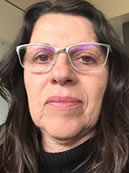 |
Maria Virginia Pires Altoé , obtained her BS in Metallurgical Engineering from UFMG and MS in Materials Engineering from UFSCAR in 1982 and 1986, respectively. After that, she joined the IFUSP to work on novel rapidly quenched magnetic alloys. Virginia obtained her PhD in Metallurgical and Materials Engineering from USP in 1994. Virginia moved to the USA in 1998, teaching materials science at Wentworth Institute of Technology in Boston before accepting a scientist position with Nanomix, Inc. in Emeryville, California. Since 2006, Virginia has been a staff of the Molecular Foundry, a NanoScience Research Center User Facility at the Lawrence Berkeley National Laboratory. |
Maria Virginia Pires Altoé
Molecular Foundry, Lawrence Berkeley National Laboratory, USA
Abstract
In order to gain a deeper understanding of materials behavior and correlate functional and structural properties at the nanometer scale it is necessary to use a variety of imaging and spectroscopic techniques able of high spatial resolution. A conventional methodology consists of taking representative samples of a material to separate instruments and interrogate them under a probe consisting of photons, electrons, x-rays, or either a force or current tunneling probe. The main limitation of this method is that the correlation arises from typical values in a set of data of structure, bonding and properties, averaging out the critical details. A more sophisticated approach that we are pursuing is to measure complementary properties on the same sample, at the same position, alloying a direct correlation of properties and specific defects or inhomogeneity. In this talk, I will present an example of combining transmission electron microscopy (TEM) and atomic force microscopy (AFM) to understand nanoscale phenomena. In organic monolayers, correlation between structure and transport properties were successfully elucidated by measuring the same location of a sample with a low electron dose scanning diffractive imaging technique and electric conductivity by means of a metallic atomic force cantilever in contact with the film. Also, TEM imaging of the tip of the cantilever before and after AFM measurement revealed with atomic precision changes in the probe as a result of tribo-chemical processes associated with the contact mode AFM experiment. In fact, we are combining AFM and TEM experiments with theoretical simulations to create an atomistic understanding of wear. These are examples of a growing portfolio where we provide a holistic understanding of materials functionality with atomic precision.